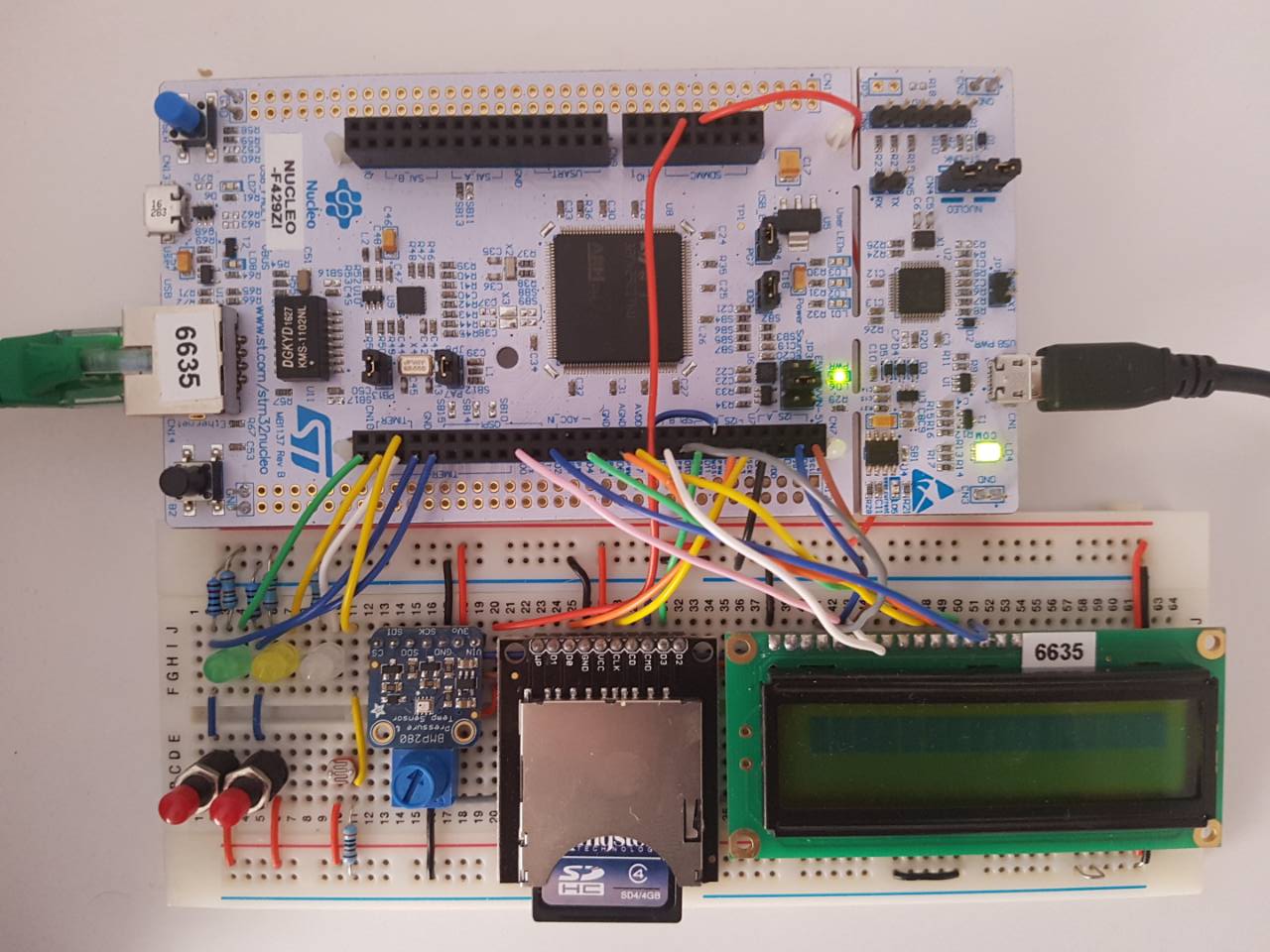Contains necessary classes and functions for ELEC351

Diff: samplingMaster/samplingMaster.cpp
- Revision:
- 2:e2b885367ba8
--- /dev/null Thu Jan 01 00:00:00 1970 +0000
+++ b/samplingMaster/samplingMaster.cpp Wed Dec 27 15:28:20 2017 +0000
@@ -0,0 +1,135 @@
+#include "mbed.h"
+#include "samplingMaster.hpp"
+
+/* Spec said that we are not allowed to use any third party code unless it is
+from ARM or STmicroelectronics, so I wrote my own driver for sampling BMP280 &
+ADC in succesion. Ths code for MPB280 was inspired by the BMP280 Datasheet:
+[https://cdn-shop.adafruit.com/datasheets/BST-BMP280-DS001-11.pdf]
+and BMP280 mbed library by "charlie":
+[https://os.mbed.com/users/CHARLY/code/BMP280/] */
+
+C_sensorData::C_sensorData()
+{
+
+ //********************************LDR ADC*********************************//
+ AnalogIn ldrADC(PA_0); // Establish Analog In for ADC
+
+ //******************************BMP280 I2C********************************//
+ I2C sensorLink(D14, D15); // Establish I2C comms
+
+ inst[0] = CONTROL_REGISTER; // Register address
+ inst[1] = 0b01101101; // Temp x4, Pressure x4, Forced mode
+ sensorLink.write(I2C_adr, inst, 2);
+
+ inst[0] = Tsb_IIR_REGISTER; // Register address
+ inst[1] = 0x00; // No standby, No IIR filter
+ sensorLink.write(I2C_adr, inst, 2);
+
+ inst[0] = DIG_Tn_REGISTERS; // Read trimming parameters instruction
+ sensorLink.write(I2C_adr, inst, 1);
+ sensorLink.read(I2C_adr, inst, 6);
+
+ /* For instructions how to decode trimming parameters please refer to the
+ BMP280 datasheet, page 21, chapter 3.11.2, table 17: "Compensation parameter
+ storage, naming and data type" */
+ T1Trim = (inst[1]<<8)|inst[0];
+ T2Trim = (inst[3]<<8)|inst[2];
+ T3Trim = (inst[5]<<8)|inst[4];
+
+ inst[0] = DIG_Pn_REGISTERS; // Read trimming parameters instruction
+ sensorLink.write(I2C_adr, inst, 1);
+ sensorLink.read(I2C_adr, inst, 18);
+
+ /* For instructions how to decode trimming parameters please refer to the
+ BMP280 datasheet, page 21, chapter 3.11.2, table 17: "Compensation parameter
+ storage, naming and data type" */
+ P1Trim = (inst[ 1]<<8)|inst[ 0];
+ P2Trim = (inst[ 3]<<8)|inst[ 2];
+ P3Trim = (inst[ 5]<<8)|inst[ 4];
+ P4Trim = (inst[ 7]<<8)|inst[ 6];
+ P5Trim = (inst[ 9]<<8)|inst[ 8];
+ P6Trim = (inst[11]<<8)|inst[10];
+ P7Trim = (inst[13]<<8)|inst[12];
+ P8Trim = (inst[15]<<8)|inst[14];
+ P9Trim = (inst[17]<<8)|inst[16];
+}
+
+TDS_sensorData C_sensorData::read()
+{
+ //*********************************SETUP**********************************//
+ TDS_sensorData sensorData; // Type def struct to hold the data
+ AnalogIn ldrADC(PA_0); // Establish Analog In for ADC
+ I2C sensorLink(D14, D15); // Establish I2C comms
+
+ /* N.B in forced mode you must write to CONTROL_REGISTER to wake the IMU up.
+ It automaticly sleeps when measurments are aquired but leaves the registers
+ readable for the I2C link */
+ inst[0] = CONTROL_REGISTER; // Register address
+ inst[1] = 0b01101101; // Temp x4, Pressure x4, Forced mode
+ sensorLink.write(I2C_adr, inst, 2);
+
+ //******************************TEMPERATURE*******************************//
+ inst[0] = TEMP_ADDRESS_VAL; // Start of temperature register
+ sensorLink.write(I2C_adr, inst, 1);
+ sensorLink.read(I2C_adr, &inst[1], 3);
+
+ tempT = (inst[1]<<12)|(inst[2]<<4)|(inst[3]>>4);
+ // ^ ^ ^
+ // MSB REGISTER LSB REGISTER X_LSB REGISTER
+
+ /* For instructions how to compensate values please refer to the
+ BMP280 datasheet, page 21 & 22, chapter 3.11.3, pseudo code */
+ tempA = ((((tempT>>3)-(T1Trim<<1)))*T2Trim)>>11;
+ tempB = (((((tempT>>4)-T1Trim)*((tempT>>4)-T1Trim))>>12)*T3Trim)>>14;
+ tempT = tempA+tempB;
+ sensorData.temp = ((float)((tempT * 5 + 128) >> 8))/100;
+
+ //********************************PRESURE********************************//
+ inst[0] = PRES_ADDRESS_VAL; // Start of presure register
+ sensorLink.write(I2C_adr, inst, 1);
+ sensorLink.read(I2C_adr, &inst[1], 3);
+
+ tempP = (inst[1]<<12)|(inst[2]<<4)|(inst[3]>>4);
+ // ^ ^ ^
+ // MSB REGISTER LSB REGISTER X_LSB REGISTER
+
+ /* For instructions how to compensate values please refer to the
+ BMP280 datasheet, page 21 & 22, chapter 3.11.3, pseudo code.
+
+ Please note that the compensation in the datasheet is done with 64 bit
+ signed values. However, "charlie's" BMP280 driver which does the
+ compensation using 32 bit signed values has inspired me to write my
+ compensation algorithm as follows. This makes the algorithm more efficient
+ without sacrifising relevant acuracy
+
+ N.B the pressure calculated by the following algorithm is in hPa which is
+ a newer unit with equivalence of: 1hPA = 1mbar*/
+
+ tempA = (tempT>>1)-64000;
+ tempB = (((tempA>>2)*(tempA>>2))>>11)*P6Trim;
+ tempB = tempB+((tempA*P5Trim)<<1);
+ tempB = (tempB>>2)+(P4Trim<<16);
+ tempA = (((P3Trim*(((tempA>>2)*(tempA>>2))>>13))>>3)+((P2Trim*tempA)>>1))>>18;
+ tempA = ((32768+tempA)*P1Trim)>>15;
+
+ if(tempA == 0) {
+ sensorData.pres = 0;
+ }
+ tempP = (((1048576-tempP)-(tempB>>12)))*3125; // Compensate for 64 bit loss
+ if(tempP < PREAS_UPER_LIMIT) {
+ tempP = (tempP<<1)/tempA;
+ } else {
+ tempP = (tempP/tempA)*2;
+ }
+
+ tempA = ((int32_t)P9Trim*((int32_t)(((tempP>>3)*(tempP>>3))>>13)))>>12;
+ tempB = (((int32_t)(tempP>>2))*(int32_t)P8Trim)>>13;
+ sensorData.pres = ((float)((tempP+((tempA + tempB+P7Trim)>>4))))/100;
+
+
+ //******************************LIGHT LEVEL*******************************//
+ sensorData.ligt = ldrADC.read(); // Read ldr value
+
+ //RETURN SENSOR DATA//
+ return sensorData;
+}
\ No newline at end of file